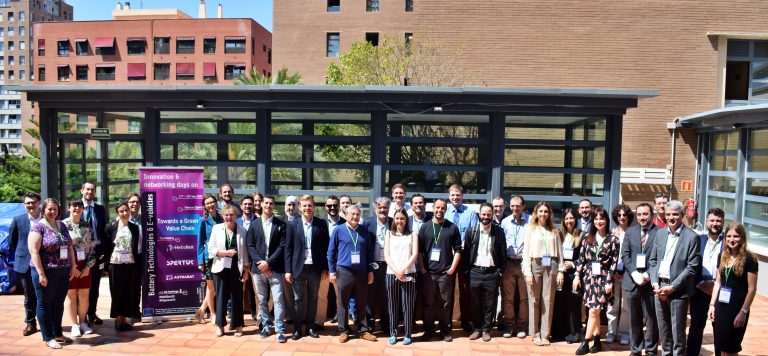On the past 4th of November of 2021, the i-HeCoBatt team organised the first project webinar on the safety and standards of batteries in Electric Vehicles (EV). The event counted with the participation of 53 attendees representing “Research and Development Organizations”, “Public Authorities”, “SME’s” and other organisations.
This meeting (moderated by LOMARTOV) offered an excellent opportunity to disseminate the project results, share experiences of other invited speakers, and also learn from related EU funded projects in terms of safety and standards.
The first part of the webinar was dedicated to the presentation of i-HeCoBatt – scope and first results, along with a brief contextualisation of the main applicable standards and regulations:
Mikel Arrinda Martínez (CIDETEC)
Introduction and Objectives (i-HeCoBatt)
i-HeCoBatt coordinator offered an introduction of how the project team pretends to achieve an intelligent cost bursting industrial battery heat exchanger to minimize the impact on full electric vehicle range in extreme conditions (see document 1).
Please wait while flipbook is loading. For more related info, FAQs and issues please refer to DearFlip WordPress Flipbook Plugin Help documentation.
Before its full industrialisation and its integration in an electric AUDI vehicle, the project is currently finalising the optimisation and testing of the ecodesigned heat exchanger prototype, together with the implementation of the diagnostic and data management software tool.
José Antonio Jiménez Caballero (UNE)
Safety Standards and Certification for Batteries in EV
Batteries are currently under the spotlight of European and national regulations, due to their importance for the electrification and green transition of the mobility, which is supported by a growing demand from the market to standardise the sector. Starting from the two main existing safety standards for EV, i.e.:
- ISO 6469-1:2019 Electrically propelled road vehicles — Safety specifications — Part 1: Rechargeable energy storage system (RESS), for the whole system, and
- IEC 62660-3:2016 Secondary lithium-ion cells for the propulsion of electric road vehicles – Part 3: Safety requirements, at cell level)
the Spanish Association for Standardisation presented an overview of the regulations and standards applicable on National, European, and International levels, highlighting the main tests to assess the system and the cell technical requirements (see document 2), as well as the future trends for novel battery standards, especially regarding their re-use and recycling as demanded by the stricter new regulatory proposal for batteries and battery wastes.
Please wait while flipbook is loading. For more related info, FAQs and issues please refer to DearFlip WordPress Flipbook Plugin Help documentation.
Iosu Erauskin Extramiana (DATIK)
Understanding the Battery Testing Methods and Standards
i-HeCoBatt partner, DATIK, presented the main supporting tool of the heat exchanger: a novel monitoring system for diagnostic and safety concerns connected to a could service. The developed software gathers the data from the sensors installed in the battery pack of the new FLEXcooler, allowing a real-time data management through a human-machine interface utilising the “cloud” service for data storage, visualisation, and diagnostic of the batteries. The main functionalities, including the tool interface from the user’s perspective and the current measurement results of this architecture, were presented, revealing the importance of novel testing tools for diagnostic and safety purposes (see document 3).
Please wait while flipbook is loading. For more related info, FAQs and issues please refer to DearFlip WordPress Flipbook Plugin Help documentation.
Mikel Arrinda Martínez (CIDETEC)
Ensuring Thermal Safety Through an Optimised Thermal Management Strategy
The presentation focused on the optimised thermal management strategy (TMS) developed in i-HeCoBatt and how the project has improved the efficiency, safety, and final cost through the proposed solution (see document 4).
Please wait while flipbook is loading. For more related info, FAQs and issues please refer to DearFlip WordPress Flipbook Plugin Help documentation.
CIDETEC presented the basis of the intelligent and adaptive control algorithm developed in the project and its integration with the rest of the components of the TMS. Simulations results were displayed, proving that the system can be integrable in any commercial microprocessor, and most of all, its performance in term of safer management of extreme operation conditions and reduction of the likelihood of catastrophic events.
The second part of the webinar was dedicated to the presentation of two Horizon 2020 funded projects working on the improvement of safety in batteries for EVs:
Adam Dicken (LEITAT)
Safe by Design: LISA Proposal
LISA coordinator presented the relevance of this project and its advancements to resolve specific Lithium-sulfur (LiS) battery problems on power rate, volumetric energy density and costs, all of which are essential selection criteria for EV cells.
The session focused on implementing the Li-S batteries using a ‘conversion mechanism’ to deliver the energy stored in the cell, and how the project improves system safety through better chemistry and inherently safer design. With the help of this improved system, the project expects to avoid thermal runaway, warn of potential failure, and minimize damage.
Alberto Gómez Núñez (EURECAT)
Novel EV Safety Management Strategies: MARBEL Proposal
MARBEL coordinator offered an overview of the project and its achievements aiming at developing an innovative and competitive lightweight battery with increased energy density, shorter recharging times and longer life.
The session focused on innovative testing processes using Artificial intelligence (AI) models output to reflect and improve the procedures and validate test results’ scalability by reducing the costs and time. Additionally, the team considered recycling materials and topological optimization, that pretend to contribute to the testing procedures and standards, providing crucial results in terms of safety, charging times and long-lasting batteries (see document 6).
Please wait while flipbook is loading. For more related info, FAQs and issues please refer to DearFlip WordPress Flipbook Plugin Help documentation.
During the session, numerous references have been made to different aspects, such as the efforts taken at European level to better regularize and standardize batteries, their use, re-use as 2nd life batteries, recycling, and the safety requirements. In this sense, the webinar provided an excellent occasion to learn from the experienced speakers about numerous strategies, tools, evaluation, and validation processes issued from R&I efforts to increase the security of batteries and, therefore, of EV.
By the end, all the attendees had the time to share their questions/answers, evaluate the webinar, and provide ideas concerning the content of the second i-HeCoBatt webinar planned for 2022.
Did you miss the webinar and want to know more about the presented sessions?
The material used during the event is available in PDF format using the links below.
We hope that this virtual meeting has been of great interest to all, and do not forget to stay tuned for the second webinar.
i-HeCoBatt Team.
November | 2021









